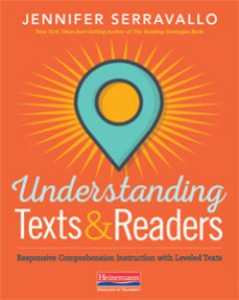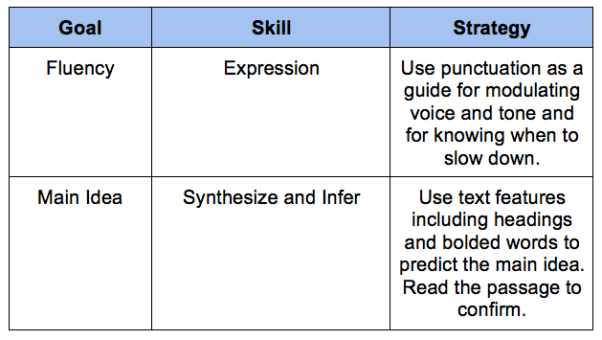Pair Just-right Texts and Reading Strategies
Understanding Texts & Readers: Responsive Comprehension Instruction with Leveled Texts
By Jennifer Serravallo
(Heinemann, 2018 – Learn more)

Every teacher who works with students as readers should read this book. All of them.
If you teach in a self-contained elementary school classroom, are a reading specialist or interventionist, teach special education, are a junior high or high school English language arts teacher, or a content teacher charged with integrating disciplinary literacy, you should read this book.

Why? Because Serravallo brings big-picture reading goals, skills, strategies and texts together in a meaningful hierarchy. My experiences teaching reading to students in all grades for the last 20 years or so confirms that when teachers choose just-right texts and pair them with appropriate goals and strategies, learning that sticks is the result.
One Book, Four Related Parts
The book is divided into four parts. Part I serves as an introduction and informs the reader of the thesis which – in a nutshell – is the following:
- Reading is understanding. Period. If a text is not understood, it is not read in the deepest meaning of the word.
- The level of the text a given student reads is or is not comprehensible to her depending on many factors. Put in a different way, the level of a text is only one way to measure if it’s a “just-right” book for a reader. Length, genre, background knowledge, interest, maturity, and other factors also matter. However, leveled texts, used carefully, can help teachers meet readers’ needs. More on this in Part IV.
- Goals, skills, and strategies are three different but related concepts. A goal is a big-picture component in reading, a skill is something a reader can do that helps her achieve the goal, and a strategy is a step-by-step way to do it. See examples below.
 Parts II and III
Parts II and III
Parts II and III focus on using leveled texts to help readers meet comprehension goals in fiction and nonfiction. Each part is further divided into three sections.
Section 1: A study of the major goals of the genre and a “crash course” on each. In fiction this includes plot and setting, character, vocabulary and figurative language, and themes and ideas. In nonfiction the goals include main idea, key details, vocabulary, and text features.
Section 2: A level-by-level guide to the characteristics of the goals in various texts. While Serravallo provides a conversion chart that includes the most common leveling systems (grade level, Fountas and Pinnell, Reading Recovery, DRA2, and Lexile), she works in the Fountas and Pinnell system. So, for each level, she runs readers through examples of what the goals might look like and the skills the teacher might focus on to help students meet the goal at increasing levels of complexity.
Section 3: A visual map is provided for each goal that shows what skills a teacher could focus on to teach a student who is reading a text at a specific level. For example, under the goal of understanding plot and setting Serravallo examines four skills (retelling, cause and effect, problem and solution, and visualize setting). She maps out what each skill would look like at text levels from J to W including examples of actual student work.
With these sections in mind, can you see why I said that in many ways this book is a good foundation for Serravallo’s earlier books on strategies? Once a teacher understands goals and the skills needed to master each of them, she can better choose specific strategies to support the development of skills.
Part IV
Part IV pulls the previous sections together with a focus on how to assess comprehension. Whole text and partial text assessment strategies are offered along with forms, procedures, and prompts to help a teacher develop them.
However, in my opinion, the most valuable and interesting information presented in this part is the illumination Serravallo provides on using leveled texts well. This is a topic that can spark much controversy and passion. (See my own thoughts on the use of leveled texts in this MiddleWeb Heart of the School post.) Serravallo shares all of the following.
- Levels are for texts, NOT readers.
- Levels can be helpful for readers to begin to determine if a text is a good fit for them.
- Levels can help teachers identify texts to use to help a given reader learn or practice a given strategy and ultimately master a specific skill connected with a big-picture reading goal.
- Good teachers can level texts or not level them and still be good teachers.
- If used, levels should serve as a guide, not the be-all-end-all way to determine if a book should or should not be read by a student.
- There are many ways to help readers, including guided reading, mini-lessons, goal-setting conferences, strong classroom libraries, book clubs, and strategy groups.
Conclusion
Serravallo is truly wise counsel when it comes to the whats, whys, and hows of teaching students to read (remember, read means comprehend). While this book is incredibly helpful because it is very precisely organized, Serravallo reminds us that real teaching and learning is never as organized as thinking about it is. She says,
Effective reading instruction may have more in common with alchemy than mechanics. In other words, teaching reading isn’t a…process of getting all of the right components to sync up just so…. Still, the more we all become aware of the individual elements—the goals and skills and the assessing, evaluating, and teaching dynamic—and do our best to thoughtfully….bring them together in the service of our students, the more likely we are to develop students who can read, want to read, and do read (p. 247).
And, if that isn’t the goal of teachers of reading, I don’t know what is. I loved this book, and for me, it will serve as a resource to be consulted often.
Read Jennifer Serravallo’s MiddleWeb article, adapted from this book.
______________________________________
Rita Platt (@ritaplatt) is a National Board Certified Teacher with master’s degrees in reading, library, and leadership. Her experience includes teaching learners in remote Alaskan villages, inner cities, and rural communities. She currently is a school principal, teaches graduate courses for the Professional Development Institute and blogs at Heart of the School for MiddleWeb.

 Parts II and III
Parts II and III

































